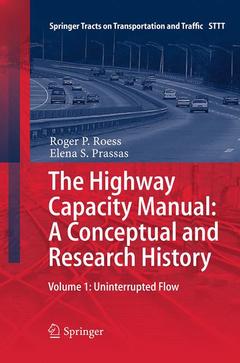Description
The Highway Capacity Manual: A Conceptual and Research History, Softcover reprint of the original 1st ed. 2014
Volume 1: Uninterrupted Flow
Springer Tracts on Transportation and Traffic Series, Vol. 5
Authors: Roess Roger . P, Prassas Elena . S
Language: English
Subjects for The Highway Capacity Manual: A Conceptual and Research...:
232.09 €
In Print (Delivery period: 15 days).
Add to cartPublication date: 09-2016
Support: Print on demand
232.09 €
In Print (Delivery period: 15 days).
Add to cartPublication date: 04-2014
470 p. · 15.5x23.5 cm · Hardback
Description
/li>Contents
/li>Comment
/li>
Since 1950, the Highway Capacity Manual has been a standard used in the
planning, design, analysis, and operation of virtually any highway traffic facility
in the United States. It has also been widely used abroad, and has spurred the
development of similar manuals in other countries.
The twin concepts of capacity and level of service have been developed
in the manual, and methodologies have been presented that allow highway
traffic facilities to be designed on a common basis, and allow for the analysis of
operational quality under various traffic demand scenarios. The manual also
addresses related pedestrian, bicycle, and transit issues.
This book details the fundamental development of the concepts of
capacity and level of service, and of the specific methodologies developed to
describe them over a wide range of facility types. The book is comprised of two
volumes. Volume 1 (this book) focuses on the development of basic principles,
and their application to uninterrupted flow facilities: freeways, multilane
highways, and two-lane highways. Weaving, merging, and diverging segments
on freeways and multilane highways are also discussed in detail. Volume 2
focuses on interrupted flow facilities: signalized and unsignalized intersections, urban streets and arterials. It is intended to help users of the manual understand how concepts,
approaches, and specific methodologies were developed, and to understand the
underlying principles that each embodies. It is also intended to act as a basic
reference for current and future researchers who will continue to develop new
and improved capacity analysis methodologies for many years to come.
Presents an overview of the research, theory and practice of highway capacity analysis
The fundamental concepts and research that have produced the methods now applied to the US roads and highways are presented in straightforward language with illustrations
Focus on Uninterrupted Flow




